- Home
- »
- Medical Devices
- »
-
Compression Therapy Market Size And Share Report, 2030GVR Report cover
![Compression Therapy Market Size, Share & Trends Report]()
Compression Therapy Market Size, Share & Trends Analysis Report By Technology (Static Compression, Dynamic Compression), By End Use, By Distribution Channel, By Region, And Segment Forecasts, 2024 - 2030
- Report ID: 978-1-68038-502-1
- Number of Report Pages: 100
- Format: PDF, Horizon Databook
- Historical Range: 2018 - 2022
- Forecast Period: 2024 - 2030
- Industry: Healthcare
Compression Therapy Market Size & Trends
The global compression therapy market size was valued at USD 4.07 billion in 2023 and is projected to grow at a compound annual growth rate (CAGR) of 7.62% from 2024 to 2030. The driving factors of the growth are attributed to rising prevalence of vein disorders such as leg ulcers, Deep Vein Thrombosis (DVT), lymphedema, varicose veins and blood clots. According to a report published by Frontiers Media S.A. in September 2023, the global incidence of five cases in 100,000 individuals is found. The incidence of this condition varies with age and affects 2-3 individuals per 100,000 in the 30-49 age group and about 20 individuals per 100,000 in the 70-79 age group. Owing to such incidences, products such as stockings and bandages are increasingly used to treat the disorders boosting the market growth.

Factors such as geriatric population, inactive lifestyles, and obesity play an important role causing conditions such as chronic venous insufficiency and venous ulcers impacting several people globally. The rising prevalence of venous ulcers paves way for advanced treatment alternatives such as compression therapy as it is highly effective to treat venous ulcers. In addition, compression therapy is an effective treatment for varicose veins compared to other alternatives. For instance, according to the Chicago Vein Institute, nearly 40 million people in U.S. suffer from varicose veins. In addition, according to the data published by NCBI in February 2024, approximately 150,000 new cases are diagnosed with chronic venous insufficiency condition with nearly USD 500 million being spent on the care of these patients.
Compression therapy works by applying pressure to the limbs, which helps in relieving symptoms, increasing blood flow, and reducing swelling. This ultimately aids in healing and prevents complications. Therefore, rising awareness of the benefits of compression therapy in treating chronic vein condition is expected to boost market growth.
The rise in the number of orthopedic procedures is another factor causing an increased demand for compression therapy as a component of postoperative care and rehabilitation protocols. The major factors causing rise in these procedures are attributed to increased geriatric population, sport-related injuries and advancements in surgical techniques giving rise to orthopedic surgeries, such as joint replacements (knee or hip replacements), fracture repairs, ligament reconstruction and arthroscopic surgeries. For instance, the American College of Rheumatology recorded about 790,000 knee replacement surgeries and 544,000 hip replacement procedures being conducted annually, and the number continues to increase owing to the rise in geriatric population.
After orthopedic surgery, patients often experience swelling, inflammation, and reduced mobility in the operated limbs. Compression therapy can benefit patients with these postoperative symptoms and provide a speedy recovery by improving blood circulation, reducing swelling, and providing relief in the operated area.
Obesity is another risk factor leading to the growing adoption of compression therapy in managing health concerns. Characterized by excessive body fat accumulation, obesity increases the risk of chronic diseases such as CVD, diabetes and hypertension, as well as causing venous insufficiency and associated disorders. For instance, according to the International Journal of Medical Science and Clinical Invention article published in 2023, obesity gives rise to conditions such as venous insufficiency and related complications by more than six-fold. In addition, according to the World Health Organization (WHO), about 2.5 billion adults aged 18 and above were found to be overweight of which 890 million were found living with obesity in 2022.
Obesity can aggravate venous insufficiency condition by increasing pressure on the veins, especially in the lower limbs. This increased pressure puts strain on the venous system, blocking the blood flow to heart, resulting in venous congestion and swelling causing discomfort to the patient. The chronic venous insufficiency can worsen over time developing serious conditions such as varicose veins, venous ulcers ad DVT. Therefore, rising prevalence of obesity is expected to surge demand in compression therapy, boosting market growth.
Market Concentration & Characteristics
The market’s growth is moderate, but the pace is accelerating. The market is characterized by a high degree of growth, owing to rising prevalences of chronic vein disorders, rise in orthopedic procedures, and growing obesity incidences.
The key companies are involved in strategic initiatives including new product launches, expansion, acquisition, establishing partnership and other activities. For instance, Medi GmbH & Co. launched Medi Rehab in October 2023, a one compression stocking available in thigh stocking and calf stocking versions with an opened or closed toe. A calf stocking with an open toe is easy and comfortable to use in conservative and postoperative treatment of ankle joint injuries or in case of Achilles tendon ruptures.
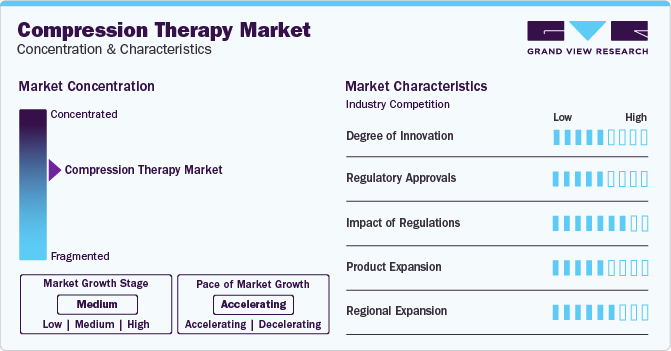
Integration of innovative technology in the compression therapy products can improve monitoring and management capabilities. Such advancements could include wearable sensors, mobile apps, or remote monitoring devices that track compression therapy efficiency, pressure levels and patient outcomes.
Medical devices such as compression therapy products are subject to stringent regulatory standards. Various regulatory bodices including U.S. FDA and European CE Mark (Conformité Européenne) are involved in establishing guidelines and standards to ensure effectiveness, safety and quality of these medical devices. Regulatory approvals are necessary to ensure various aspects of innovation in compression therapy such as product design, materials used and integrated features. Manufacturers are required to adhere to the regulatory guidelines that help to ensure new and improved products meet the set quality standards.
Regulatory bodies are establishing quality and safety standards for medical equipment such as compression therapy products. Manufacturers are required to comply with these standards to ensure the safety of patients during transportation. In addition, the regulatory compliance encourages the manufacturers to adhere to eco-friendly practices in the production and disposal of compression therapy.
Product expansion in the global market involves introducing new products or enhancing existing ones to meet the evolving patient needs, technological advancements, and changing market demands. The key players in the market can innovate new product lines to address a specific market segment. This may include developing compression garments for different anatomical areas such as arms, legs, and torso or can be used in specific conditions such as lymphedema and venous insufficiency.
The market exhibits elements of both fragmentation and consolidation, varying depending on factors such as product type, geographical location, and market segment. In specific segments of the market, especially with numerous manufacturers and suppliers, the market can be fragmented. This fragmentation could be a result of several small and medium-sized companies offering compression therapy products, including compression garments, bandages, stockings and devices. This may create a competitive nature among companies based on factors such as price, product variation, and distribution channels. On the other hand, the market is characterized by consolidation, in segments dominated by a few large-scale players holding significant market share. Such big players have established brand recognition, wide distribution networks, and diverse product portfolios encompassing a wide range of compression therapy solutions.
The market is influenced by factors such as advancements in healthcare infrastructure, rising prevalence of chronic diseases, and technological innovations in the compression therapy field including development of innovative and improved product designs enhancing patient comfort. Regional expansions are driven by several factors such as rising geriatric population, increasing incidences of chronic diseases, growing awareness of venous disorders, and development in healthcare infrastructure.
Technology Insights
Static compression therapy dominated the market and accounted for a share of 69.2% in 2023. The segment entails applying consistent pressure on the affected areas to increase blood flow and reduce swelling. It utilizes compression garments such as stockings, bandages, wraps which are known to ease discomfort and enhance the effectiveness in treating conditions including varicose veins, Deep veins Thrombosis (DVT), and lymphedema. The therapy known to ease discomfort and its convenient use makes it a preferred choice for patients and physicians. Static compression therapy offers effective pressure & pain relief, speedy functional recovery, and reduction of swelling, crucial to treat various sport injuries and associated conditions. These static devices are versatile, and suitable for various medical conditions, and can offer levels of compression depending on the severity of the condition. This technology is more affordable than dynamic compression, making it a preferred choice for patients due to its cost-effectiveness, especially in the limited healthcare budget regions.
The dynamic compression therapy segment is expected to register the fastest CAGR of 4.3% during the forecast period. This technology in compression therapy is gaining traction in the market owing to various factors and trends. It involves the application of pressure to the affected area, which can be adjusted over time to increase blood circulation and reduce swelling. This includes dynamic compression pumps. Dynamic compression therapy offers a flexible approach which allows it to adjust the pressure levels depending on patient needs opposed to static therapy where the pressure remains constant. The flexibility in the pressure makes it an effective treatment alternative to treat conditions such as postsurgical wounds and injury pains.
End Use Insights
Hospitals dominated the market and accounted for a share of 32.6% in 2023. Hospitals are a preferred location over other healthcare facilities due to their ability to offer comprehensive care to patients with complex medical needs. Hospitals are well equipped with necessary infrastructure, expert professionals and abundant resources ensuring optimal treatment outcomes effectively managing and monitoring patient conditions. In addition, the hospitals can provide immediate access to advanced medical care in case of emergencies or other complications. Compression therapy products are widely used in hospitals to treat conditions such as venous disorders, lymphedema, and postsurgical recovery. The adoption of these products in hospitals has increased due to their proven efficiency in treating complicated conditions and improving patient outcomes.
The home healthcare segment is expected to register the fastest CAGR of 5.0% during the forecast period. Compression therapy at home is used to treat conditions such as varicose veins, DVT, lymphedema, orthostatic hypotension, sports injuries, and leg ulcers. The patient self-management strategies owing to user-friendly and wearable compression therapy products drives the home healthcare segment. These devices are specially designed to be used in home settings allowing the patients to manage their conditions without frequent visits to the healthcare facilities. In addition, the increased use of telemedicine and integrating therapy consultations, fitting services enhances access to healthcare and supporting remote patient monitoring services. Such instances are expected to drive the segment growth.
Distribution Channel Insights
Institutional sales segment dominated the market and accounted for a share of 60.4% in 2023. It involves distributing the medical products through various channels such as hospitals, clinics, and nursing homes, offering several advantages over retail sales including selling products in large quantities, reducing marketing costs and potential to establish long-term business relationships with the potential customers in the market. The segment growth is further attributed to increased demand for compression therapy products in healthcare. The growing geriatric population and rising chronic conditions such as chronic venous insufficiency, lymphedema, and DVT, have accelerated the need for advanced solutions such as compression therapy. Institutional sales offer an effective and dependable way to deliver the products to healthcare providers.
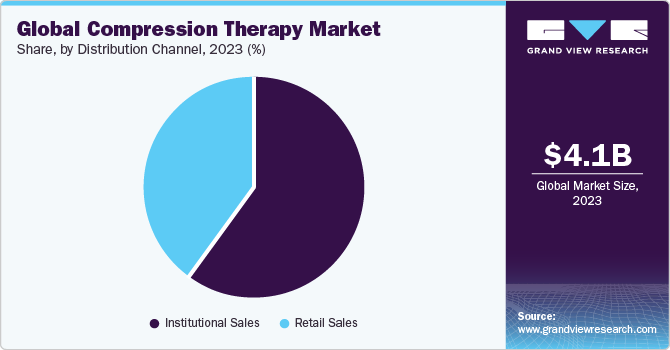
The retail sales segment is expected to register at the fastest CAGR of 4.7% during the forecast period. It involves distributing products through channels such as pharmacies, medica supply stores and online retailers. The segment offers higher accessibility to compression therapy products for consumers, offering a wide range of alternatives allowing the consumers to compare and select the best solutions suited for their needs. In addition, retail sales offer convenience allowing the consumers to purchase products without prescriptions or frequent visits to the healthcare professionals. Such benefits and convenience over other means is expected to boost the segment growth.
Regional Insights
North America dominated the compression therapy market with a revenue share of 42.77% in 2023, owing to factors such as technological advancements, increased prevalence of chronic diseases and government initiatives. The market growth is further attributed to technological advancements in compression therapy such as the development of innovative materials and improved designs enhancing patient comfort and experience. The rising prevalence of chronic disease including diabetes coupled with obesity lead to circulatory issues, contributing to the market growth in the region. For instance, the National Institutes of Health article published in April 2023 reported more than 25 million people in U.S. are affected with varicose veins and nearly 6 million people suffer from severe venous disease making the Chronic Venous Disease (CVD) a prevalent health condition. Such rising incidences drives market growth of compression therapy in the region.
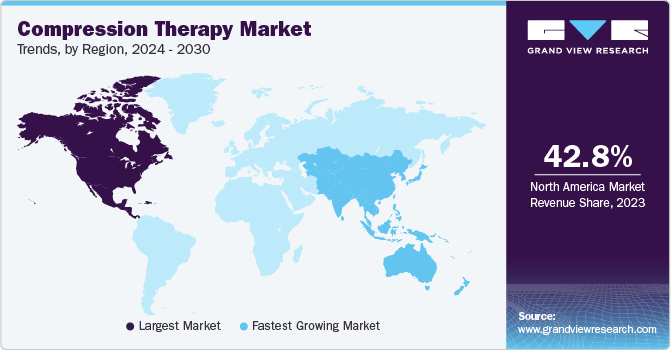
U.S. Compression Therapy Market Trends
The compression therapy market in U.S. is expected to dominate the market over the forecast period. The factors driving the market growth include rising prevalence of chronic diseases such as Peripheral Artery Disease (PAD) and growing geriatric population. According to a research article published by Vascular Disease Management in April 2023, the U.S. population's PAD prevalence has increased from 11.3 million in 1995 to an estimated 26 million in 2020. Such rising prevalences are commonly attributed to aging population, causing a rise in demand for compression therapy. In addition, growing awareness about the compression therapy and benefits offered in conditions such as PAD, Deep Vein Thrombosis (DVT), and post-thrombotic syndrome further drives the market growth due to its proven effectiveness supported by research, clinical trials and patient testimonials.
Europe Compression Therapy Market Trends
The compression therapy market in Europe is expected to grow at a significant CAGR over the forecast period. The market growth in Europe region is attributed to rising geriatric population and technological advancements in the compression therapy field. In addition, the advanced healthcare infrastructure and focus driven invasive medical interventions boost the market growth.
The UK compression therapy market is expected to grow at a moderate CAGR over the forecast period. The factors owing to this growth include rising geriatric population, rising prevalence of venous ulcers, foot ulcers and edema boosts the adoption of compression therapy in the country. According to the British Heart Foundation data, approximately 60,000 people are annually affected with DVT in UK. Such rising prevalences are driving the adoption of compression therapy including compression hosiery, bandaging, or other devices, playing a critical role in DVT management.
The compression therapy market in France is expected to grow at the fastest CAGR over the forecast period, owing to rising geriatric population and increasing prevalence of CVDs, driving market growth.
The Germany compression therapy market is anticipated to witness a steady CAGR over the forecast period. The factors driving market growth in the country include rising geriatric population, growing chronic disease prevalence and increased demand for better healthcare infrastructure. Such factors are expected to drive the compression therapy market growth
Asia Pacific Compression Therapy Market Trends
The compression therapy market in the Asia Pacific region is estimated to register the fastest CAGR over the forecast period. This market growth can be attributed to the increasing prevalence of chronic diseases, such as venous disorders, lymphedema, and DVT, and rising geriatric population among the region's population. According to the National Center for Biotechnology Information article published in October 2022, the VTE rates in Asia were considered lower than other regions. For instance, venous thromboembolism (VTE) occurrence was estimated to 0.2 per 1,000 persons in South Korea. In addition, the rise in geriatric population and rising awareness about the benefits of using compression therapy propelled the market growth. Further, technological advancements such as innovative compression garment designs and materials have enhanced patient comfort, boosting the demand for these products resulting in market growth.
The China compression therapy market is expected to grow at the fastest CAGR over the forecast period, owing to the growing geriatric population and the increasing prevalence of chronic disorders, such as diabetes & cardiovascular conditions, which have increased the demand for compression therapy products.
The compression therapy market in India is driven by factors such as the country’s escalating burden of chronic diseases, such as diabetes, obesity, and venous disorders, which necessitates effective management of related symptoms such as poor circulation & swelling, thereby driving demand for compression therapy solutions. For instance, a study published by the Indian Council of Medical Research, India Diabetes (ICMR INDIAB) reported 101 million people in the nation suffering from diabetes.
The Japan compression therapy market is expected to grow at the fastest CAGR over the forecast period, owing to several key factors, such as the rising geriatric population, technological advancements, and product innovations.
Middle East and Africa Compression Therapy Market Trends
The compression therapy market in the Middle East and Africa is expected to witness a significant CAGR during the forecast period. The market growth is driven by factors such as increased healthcare infrastructure investment and rising chronic disease prevalences. Such factors are expected to boost the development in the medical device industry in the region. In addition, growing health insurance penetration, increasing privatization, and rising regional disease burden are factors expected to drive regional market growth.
The Saudi Arabia compression therapy market is expected to grow at the fastest CAGR over the forecast period. The prevalence of CVI is significantly high in the nation affecting 45.6% adult population, especially in Western region. This high prevalence is owed to lifestyle changes, and risk factors age, family medical history, occupational hazards, and use of hormonal therapy. Such factors make the region potentially a competitive market for CVI treatment alternatives emphasizing need for innovating solutions and address prevalent risk factors with targeted interventions.
The compression therapy market in Kuwait is expected to grow at a significant CAGR over the forecast period, owing to escalating prevalence of chronic conditions and rising healthcare expenditure.
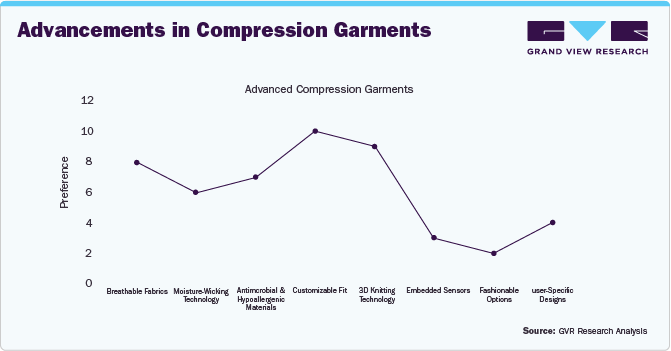
Here are several key advancements in compression garments:
-
Modern compression garments use breathable fabrics, moisture-wicking technology, and antimicrobial and hypoallergenic materials to improve comfort, reduce skin irritation, and prevent bacterial growth, while also reducing the risk of allergies and skin irritation.
-
Advanced knitting techniques enable varying compression levels within a garment, enhancing blood circulation by being strongest at the extremities and decreasing towards the core.
-
Advancements in body scanning and 3D printing technology enable personalized compression garments, providing optimal comfort and minimal waste, while 3D knitting technology enhances comfort and sustainability.
-
Modern compression garments use embedded sensors to monitor physiological parameters, enabling real-time performance optimization and health monitoring. Integration with mobile apps allows users to track progress, adjust training or treatment, and share information.
-
Compression garments offer fashionable options in various colors, patterns, and styles, and are designed for specific user groups including pregnant women, athletes, or patients recovering from specific surgeries.
-
Modern compression garments are enhanced by durable fabrics and easy-care routines, making them resistant to wear and tear, deformation, and loss of compression.
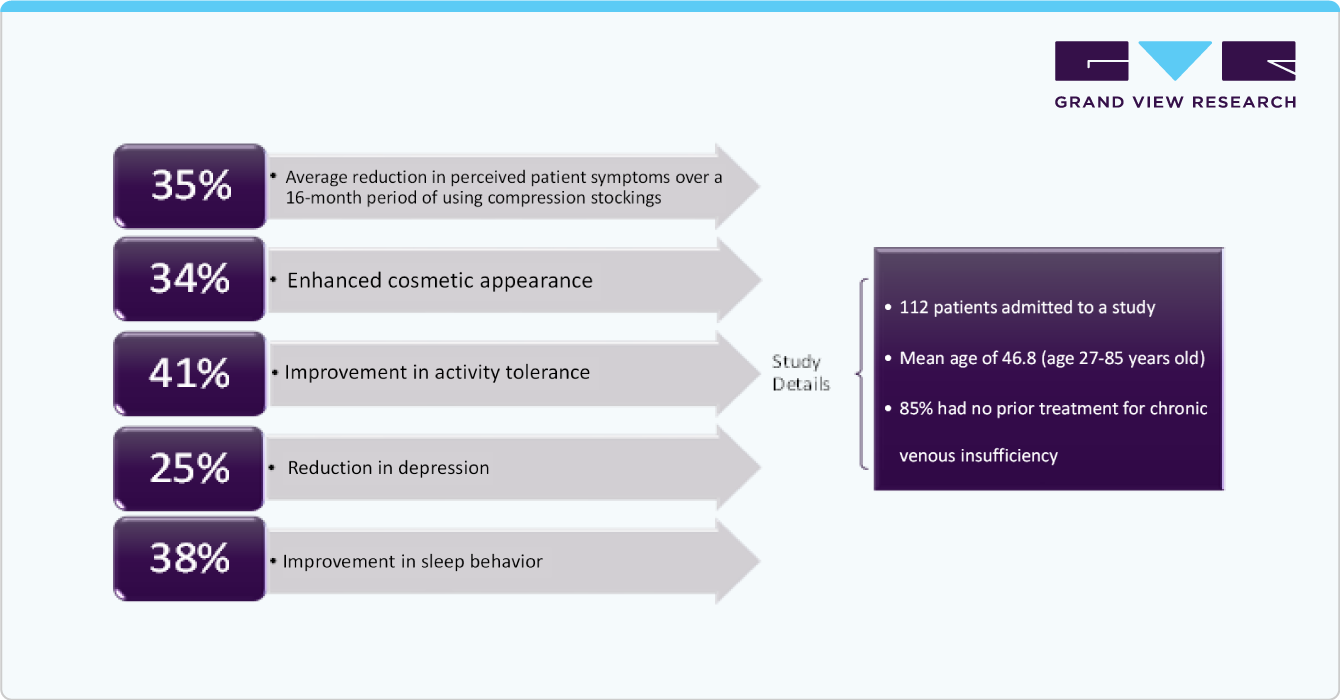
A patient-centric approach to compression therapy: the use and adoption of a novel mobile application to support the clinical selection of medical compression hosiery.
Compression therapy is widely recognized as an effective treatment option for the management of lower limb conditions. However, it is noted that clinicians do not always use it appropriately. Lack of knowledge and clinical uncertainty, coupled with increased workload and reduced time spent with the patients can lead to inappropriate compression decisions.
A research article published by Wound UK in November 2023, examined the use of Hosiery Hunter app (medi UK) and its role in medical decision making. The Hosiery Hunter app is a mobile application that simplifies the process of selecting medical supplies for patients suffering from lower-limb conditions. Based on data gathered from used feedback survey, the Hosiery Hunter application offered hassle-free solution to select appropriate compression therapy, saving time and providing fast and timely access to the prescription.
Clinical Results and Studies
Tactile Medical has invested in several research studies that generate clinical and economic outcome data supporting their product and demonstrate its effectiveness. To date, more than 25 studies concerning the safety and efficacy of the firm’s products have been completed, in which above 2,100 subjects have been included. Few of them studying the efficacy of Flexitouch System are listed below:
-
Economic Impact of Tactile Medical’s Flexitouch System in Patients with Phlebolymphedema
-
Impact on Clinical Outcomes and Healthcare Costs with Use of Flexitouch System
-
Flexitouch System Impact on Limb Volume and Patient-Reported Outcome
-
Comparison of Flexitouch System with Simple Pneumatic Compression Devices
-
Study of Patient-Reported Satisfaction with Use of Flexitouch System
- Flexitouch System Impact on Patient-Reported Improved Quality-of-Life
Shift Towards E-commerce
Digital technology is transforming the way a company conducts business and building relationships with consumers, patients and caregivers. For instance, Essity firm focuses on digital channels reflecting a broader trend in the industry towards investing in e-commerce to cater the evolving consumer needs and behaviors.
Through the digital transformation, Essity has expanded its distribution channels digitally in recent years. Digital interactions with customers and consumers help the firm to understand their needs and improve communication and engagement. For instance, in 2023, Essity e-commerce sales increased by 9.8% to SEK 14 billion (USD 1.29 billion), accounting for around 9% net sales of the company. Additionally, Direct-To-Consumer (D2C) marketing can help attract new customers, strengthen existing relationships, and increase brand loyalty.
Key Compression Therapy Company Insights
Cardinal Health; Julius Zorn GmbH; Hartmann AG; Medi GmbH & Co.; SIGVARIS; BSN Medical GmbH; ArjoHuntleigh; 3M Health Care; Spectrum Healthcare; Bio Compression Systems, Inc.; Stryker; Gottfried Medical, are some of the major players in the global market. The market has been witnessing notable trends that are impacting the activities of emerging players in the industry. The key players offer a wide range of compression therapy products such as compression garments, stockings, wraps, and devices to treat various medical conditions including venous disorders, lymphedema, and wound healing. Additionally, new players are emerging, and various startups are entering the industry to offer innovative solutions and disrupt traditional market dynamics. These companies focus on niche segments or develop novel technologies to address unmet needs in wound care management and vascular health.
Furthermore, technological advancements in compression therapy have l;ed to development of innovative products and treatment modalities. Some notable advancements include smart compression technology, 3D printing, gradient compression systems, cold compression therapy, hydrotherapy compression devices, etc. Besides, companies in the global market are increasingly focusing on developing patient-centric solutions prioritizing comfort, convenience, and usability.
Key Compression Therapy Companies:
The following are the leading companies in the compression therapy market. These companies collectively hold the largest market share and dictate industry trends.
- Essity Aktiebolag (publ).
- Cardinal Health
- Julius Zorn GmbH
- Hartmann AG
- Medi GmbH & Co.
- SIGVARIS
- BSN Medical GmbH
- ArjoHuntleigh
- 3M Health Care
- Spectrum Healthcare
- Bio Compression Systems, Inc.
- Stryker
- Gottfried Medical
- Tactile Medical
Recent Developments
-
In June 2023, Medi GmbH Co. introduced new medical compression offerings including circular & flat-knit variants, designed to cater to diverse needs and preferences in the healthcare sector.
-
In October 2023, MediWound announced strategic partnership with 3M for clinical trial of EscharEx phase III.
-
In September 2023, Tactile Medical received a patent for a new compression garment system. This system uses adjustable pressure to move fluids within the body towards specialized cells that help manage those fluids.
-
In May 2022, Medline Industries, LP. Launched skin health and compression workshops for Healthline workers.
Compression Therapy Market Report Scope
Report Attribute
Details
Market size value in 2024
USD 4.25 billion
Revenue forecast in 2030
USD 5.34 billion
Growth Rate
CAGR of 7.62% from 2024 to 2030
Base year for estimation
2023
Historical data
2018 - 2022
Forecast period
2024 - 2030
Quantitative units
Revenue in USD million and CAGR from 2024 to 2030
Report coverage
Revenue forecast, company ranking, competitive landscape, growth factors, and trends
Segments covered
Technology, end use, distribution channel, region
Regional scope
North America, Europe, Asia Pacific, Latin America, MEA
Country scope
U.S.; Canada; Mexico; UK; Germany; Italy; France; Spain; Denmark; Sweden; Norway; Japan; China; India; South Korea; Australia; Thailand; Brazil; Argentina; South Africa; Saudi Arabia; UAE; Kuwait
Key companies profiled
Essity Aktiebolag (publ); Cardinal Health; Julius Zorn GmbH; Hartmann AG; Medi GmbH & Co.; SIGVARIS; BSN Medical GmbH; ArjoHuntleigh; 3M Health Care; Spectrum Healthcare; Bio Compression Systems, Inc.; Stryker; Gottfried Medical; Tactile Medical
Customization scope
Free report customization (equivalent up to 8 analysts working days) with purchase. Addition or alteration to country, regional & segment scope.
Pricing and purchase options
Avail customized purchase options to meet your exact research needs. Explore purchase options
Global Compression Therapy Market Report Segmentation
This report forecasts revenue growth at regional and country levels and provides an analysis of the latest industry trends in each of the sub-segments from 2018 to 2030. For this study, Grand View Research has segmented the global compression therapy market report based on technology, end-use, distribution channel, and region:
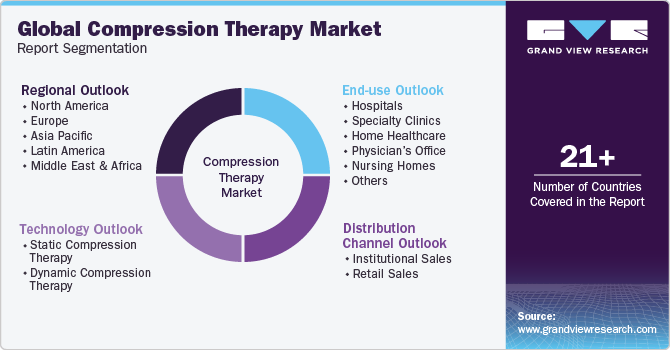
-
Technology Outlook (Revenue, USD Million, 2018 - 2030)
-
Static Compression Therapy
-
Compression Bandages
-
Compression Stockings
-
Compression Tape
-
Others Compression Garments
-
-
Dynamic Compression Therapy
-
Compression Pumps
-
Compression Sleeves
-
-
-
End-use Outlook (Revenue, USD Million, 2018 - 2030)
-
Hospitals
-
Specialty Clinics
-
Home Healthcare
-
Physician’s Office
-
Nursing Homes
-
Others
-
-
Distribution Channel Outlook (Revenue, USD Million, 2018 - 2030)
-
Institutional Sales
-
Retail Sales
-
-
Regional Outlook (Revenue, USD Million, 2018 - 2030)
-
North America
-
U.S.
-
Canada
-
-
Europe
-
UK
-
Germany
-
France
-
Italy
-
Spain
-
Denmark
-
Sweden
-
Norway
-
-
Asia Pacific
-
Japan
-
China
-
India
-
Australia
-
Thailand
-
South Korea
-
-
Latin America
-
Brazil
-
Mexico
-
Argentina
-
-
Middle East & Africa
-
South Africa
-
Saudi Arabia
-
UAE
-
Kuwait
-
-
Frequently Asked Questions About This Report
b. The global compression therapy market size was estimated at USD 4.07 billion in 2023 and is expected to reach USD 4.25 billion in 2024.
b. The global compression therapy market is expected to grow at a compound annual growth rate of 3.88% from 2024 to 2030 to reach USD 5.34 billion by 2030.
b. North America dominated the compression therapy market with a share of 42.77% in 2023. This is attributable to favorable government reimbursement plans, high incidence of chronic venous disorders and growing healthcare awareness level.
b. The key players operating in the compression therapy market are Essity Aktiebolag (publ), Cardinal Health; Julius Zorn GmbH; Hartmann AG; Medi GmbH & Co.; SIGVARIS; BSN Medical GmbH; ArjoHuntleigh; 3M Health Care; Spectrum Healthcare; Bio Compression Systems, Inc.; Stryker; Gottfried Medical, Tactile Medical.
b. Key factors that are driving the market growth include the increasing prevalence of venous disorders, rising significance in the treatment of sports injuries and a significant increase in orthopedic surgeries across the world.
Share this report with your colleague or friend.
![gvr icn]()
NEED A CUSTOM REPORT?
We can customize every report - free of charge - including purchasing stand-alone sections or country-level reports, as well as offer affordable discounts for start-ups & universities. Contact us now
![Certified Icon]()
We are GDPR and CCPA compliant! Your transaction & personal information is safe and secure. For more details, please read our privacy policy.
We are committed towards customer satisfaction, and quality service.
"The quality of research they have done for us has been excellent."





